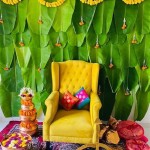How to Decorate a Mandir at Home for Diwali
Diwali, the festival of lights, is a time for celebration, family gatherings, and spiritual reflection. A central element of Diwali celebrations in many Hindu households is the decoration of the home temple, or Mandir. A well-decorated Mandir not only enhances the festive atmosphere but also provides a sacred space for prayer and worship during this auspicious time. The process of decorating a Mandir for Diwali involves careful planning and consideration of traditional and contemporary elements to create a visually appealing and spiritually uplifting environment.
The decorations typically include a combination of lights, floral arrangements, rangoli designs, and carefully placed idols. The goal is to create a space that is both aesthetically pleasing and conducive to prayer and meditation. This article outlines key considerations and practical steps to guide the process of decorating a Mandir at home for Diwali.
Choosing the Right Location and Preparing the Space
The location of the Mandir within the home is a crucial first consideration. Ideally, the Mandir should be situated in a peaceful and quiet area, away from the bustle of daily activities. The northeast corner of the home is often considered the most auspicious direction, aligning with Vastu Shastra principles. If a dedicated room is unavailable, a designated corner or wall space can be transformed into a Mandir.
Before commencing the decoration process, it is essential to thoroughly clean the Mandir and its surrounding area. This involves removing any dust, cobwebs, or clutter. Wipe down the idols with a soft cloth and ensure that the area is free of any disorganization. A clean and organized space sets the foundation for a positive and spiritually charged atmosphere.
Examine the existing lighting fixtures around the Mandir. Consider whether additional lighting is needed to enhance the ambiance. Evaluate the surrounding wall space and floor area to determine the best placement for decorative elements like rangoli, floral arrangements, and lighting. The goal is to create a harmonious and balanced visual composition.
Once the cleaning is complete, it is advisable to repaint or touch up the walls around the Mandir if necessary. Fresh paint can significantly enhance the overall appearance and create a more vibrant backdrop for the decorations. Choose colors that are considered auspicious, such as yellow, orange, or light blue. These colors are often associated with positivity and spirituality.
Selecting Decorations: Lights, Flowers, and Fabrics
Diwali is synonymous with lights, and their incorporation into the Mandir decoration is paramount. Traditional diyas (oil lamps) are a classic choice, symbolizing the triumph of good over evil and the dispelling of darkness. Place diyas around the Mandir, on shelves, and along the perimeter to create a warm and inviting glow. Ensure the diyas are placed safely and away from flammable materials.
Electric lights, such as string lights or LED lamps, offer a modern alternative or supplement to diyas. These lights come in a variety of colors and styles, allowing for customization to suit personal preferences. Wrap string lights around the Mandir structure, drape them along the walls, or use them to highlight specific idols. Opt for lights that emit a soft, warm glow rather than harsh, bright light to maintain a serene atmosphere.
Flowers are an integral part of Mandir decorations, symbolizing purity, devotion, and beauty. Fresh flowers, such as marigolds, roses, and jasmine, are traditionally used to adorn the idols and the surrounding area. Create garlands to drape around the idols, place flower petals at their feet, and arrange bouquets in vases. Choose flowers that are fragrant and visually appealing.
Consider using artificial flowers as a longer-lasting alternative, particularly if maintaining fresh flowers is not feasible. Artificial flowers can be reused year after year and offer a wide range of colors and styles. However, ensure that the artificial flowers are of good quality and resemble fresh flowers as closely as possible.
Fabrics play a significant role in enhancing the aesthetic appeal of the Mandir. Use colorful and decorative fabrics to create a backdrop for the idols. Silk, satin, or brocade fabrics are often preferred for their luxurious texture and vibrant colors. Drape the fabric behind the idols or use it to create a canopy overhead. Choose fabrics that complement the overall color scheme and theme of the decorations.
Incorporate cushions and mats made of comfortable and decorative fabrics to create a comfortable space for prayer and meditation. Place these cushions and mats around the Mandir, allowing family members and visitors to sit and pray comfortably. Choose fabrics that are easy to clean and maintain.
Creating Rangoli Designs and Adding Personal Touches
Rangoli, an intricate art form using colored powders or rice flour, is a traditional Diwali decoration. Creating a rangoli design near the Mandir entrance or in front of the idols adds a festive and welcoming touch. Rangoli designs can vary in complexity, ranging from simple geometric patterns to elaborate depictions of deities or auspicious symbols.
Use stencils to create symmetrical and precise rangoli designs, or opt for freehand designs if comfortable with the art form. Choose colors that are vibrant and auspicious, such as red, yellow, orange, and green. Add decorative elements like diyas, flower petals, or beads to enhance the rangoli design. Ensure the rangoli is placed in a location where it will not be easily disturbed.
Personalize the Mandir decorations by incorporating items that hold special significance to the family. This could include photographs of ancestors, religious texts, or handcrafted items. These personal touches add a unique and meaningful element to the decorations.
Consider adding religious symbols, such as Om or Swastika, to the decorations. These symbols are considered auspicious and can enhance the spiritual atmosphere of the Mandir. They can be incorporated into the rangoli design, painted on the walls, or used as decorative accents.
Include incense sticks and essential oil diffusers to create a pleasant and aromatic atmosphere. The fragrance of incense and essential oils can enhance the meditative environment and promote a sense of peace and tranquility. Choose scents that are traditionally associated with worship, such as sandalwood, jasmine, or rose.
Finally, remember that the most important aspect of decorating the Mandir is the intention and devotion behind the effort. Approach the process with a sense of reverence and gratitude, and focus on creating a space that is conducive to prayer and spiritual reflection. The decorations should reflect the family's beliefs and traditions, and should be a source of joy and inspiration during the Diwali celebrations.
Maintain cleanliness throughout the Diwali period. Regularly sweep the floor around the Mandir, replace wilted flowers, and ensure the diyas are properly lit. This ongoing maintenance contributes to the overall positive ambiance of the space.
Involving family members in the decoration process can make it a memorable and bonding experience. Delegate tasks, share ideas, and work together to create a beautiful and spiritually uplifting Mandir for Diwali. This collaborative effort can foster a sense of unity and shared purpose within the family.
Ultimately, the goal of decorating the Mandir for Diwali is to create a sacred space that honors the divine and provides a focal point for prayer and reflection during this auspicious festival. By carefully considering the location, decorations, and personal touches, a home Mandir can be transformed into a beautiful and spiritually enriching environment for Diwali celebrations.

Small Home Temple Festival Decor Ideas Er Friendly Mandir Diwali Decoration

35 Diwali Mandir Decoration Ideas With Diyas Flowers More

35 Diwali Mandir Decoration Ideas With Diyas Flowers More

Diwali Pooja Room Decoration Tips Beautiful Homes

Mandir Decoration Diy Diwali Ideas How To Decorate

35 Diwali Mandir Decoration Ideas With Diyas Flowers More

Diwali Mandir Temple Decoration Pooja Ideas At Home Puja Area Decor For Festivals

Diwali Decoration

Diwali Decoration Final Touches For A Ready Home

Mandir Decoration For Diwali 2025 Ideas







